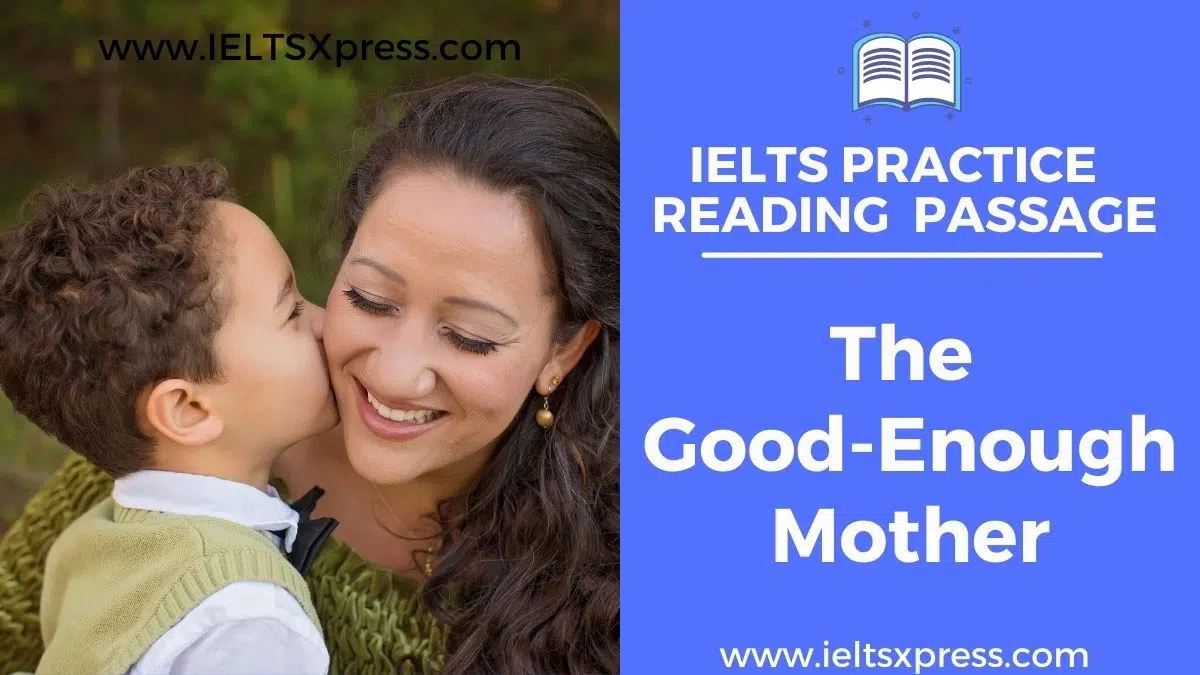The Good Enough Mother IELTS Reading Passage with Answers
Reading Passage 3
You should spend about 20 minutes on Questions 27-40 which are based on Reading Passage 3 below.
The Good-Enough Mother
Throughout history, new parents have experienced the pressures and responsibilities that come with rearing a child. The mother in particular, for biological and societal reasons, is under stress to fulfill the expectations that she and society puts on her. Donald Winnicott, a British paediatrician and psychoanalyst, broke ground and shocked those around him with his original views on the relationship between children and their mothers. Winnicott challenged the traditional and idealised view of parenting and provided theory and guidance that was more grounded in the reality of parenthood. Winnicott’s notions of the ‘good-enough’ mother and the facilitating environment that he described remain important in the study of child development.
It would not be an exaggeration to say that most parents try to provide the best for their children, and many feel guilty when they are not able to do so, especially when many women and men in the modern world try to balance personal and professional lives with perfect parenthood. This key role for adults in today’s world has led to this subject being intensively examined and various theories of parenting being created. While a variety of models have informed the development of parenting programmes, four core theories underpin the majority of them.
Social learning theory is based on the assumption that children’s behaviour will improve when appropriately reinforced; good behaviour is rewarded and bad behaviour is either ignored or appropriately sanctioned. Social learning theory-based programmes teach parents strategies for punishing child misconduct and rewarding positive behaviour.
Attachment theory is based on the notion that an infant’s ability to form a strong emotional bond with their primary caregiver is a natural part of its development. The security of this bond, also known as attachment security, is largely determined by the parents’ ability to respond sensitively and appropriately to their infant’s bids for attention. Programmes based on attachment theory therefore aim to improve parental sensitivity by increasing parents’ understanding of their children’s requirements and attachment related conduct.
Parenting styles theory is based on research that suggests children’s behaviour is directly related to their parent’s child-rearing practices. Parents who combine high levels of parental warmth with high levels of supervision are likely to have children who are more confident, more autonomous and more socially responsible. This parenting style is often referred to as an authoritative style of parenting, as it recognises the child as an individual in his or her own right. For this reason, many parenting programmes include elements that encourage parents to allow their children to experience risk-taking amidst high levels of supervision.The model of human ecology assumes that a child’s development is determined by his or her interaction within the environments of the individual, family, school, community and culture. Each of these environments contains elements that can either improve a child’s life outcomes or place them at risk for adversity. Every family is unique in terms of these risk and protective factors influencing it. Programmes based on this model consider ways to strengthen protective factors in order to manage any on-going risks.
Winnicott’s idea of a facilitating environment created for a child by a ‘good-enough mother’, who is supported by the adults around her, rests easily alongside the theory of attachment. Winnicott’s facilitating environment is provided by an unconscious process within an ordinary mother who is fond of her baby. Winnicott suggests that during pregnancy, a mother develops a state of heightened sensitivity, which continues to be maintained for some weeks after the baby’s birth. When this heightened state passes, the mother has what Winnicott calls a ‘flight into sanity’, and she begins to be aware of the world that exists outside of her state of primary maternal preoccupation with her infant.
The good-enough mother then continues to provide an environment that facilitates healthy maturational processes in her baby. She achieves this by being the person who wards off the unpredictable and who actively provides care in the holding, handling and in the general management of the child. The good-enough mother provides physical care and meets her baby’s need for emotional warmth and love. She also protects her baby against those parts of her from which murderous feelings are brought forth when, for example, her baby screams, yells and cries continuously. By containing her own hateful feelings about her baby, and using them to intuit the baby’s terror and hate, the good-enough mother facilitates her baby’s thoughts and expressions of omnipotence by adapting to his needs until such time as he gradually begins to feel safe enough to relinquish these feelings. At this stage, the process of integration can start and the baby begins to develop a sense of ‘me’ and ‘not me’. To achieve this shift in the baby, the good-enough mother must, by a gradual process, fail to adapt to her baby’s needs in order that the baby can begin to learn to tolerate the frustrations of the world outside of himself and his mother.
Winnicott intended to take the pressure off women who became mothers, but critics have argued that Winnicott’s idea of the good-enough mother has placed the undue expectations upon the ‘real’ mother that she must shoulder most of the responsibility for the care of her baby. Furthermore, she is held responsible for how well her baby flourishes.
Like many social theories of child development, it is clear to outsiders that real life practice exhibits characteristics of all theory and most parents show parts of each theory in order to adapt naturally to whatever situations arise. Nevertheless, Winnicott’s ideas have been a source of comfort and hope to many mothers who have naturally struggled with the challenge of motherhood.
Questions 27-30
Do the following statements agree with the views of the writer of the text?
In boxes 27-30 on your answer sheet write:
YES if the statement agrees with the writer’s views
NO if the statement doesn’t agree with the writer’s views
NOT GIVEN if it is impossible to say what the writer thinks about this
27 Mothers are under pressure from themselves and society’s expectations to be good mothers.
28 Today, the field of child development is not influenced much by Winnicott’s theories.
29 A man’s traditional role as the breadwinner means that he has less pressure to be an excellent parent.
30 Parenting has not been a subject that has been widely studied.
Questions 31-36
Complete the table below.
Write NO MORE THAN TWO WORDS from the text for each answer.
Write your answers in boxes 31-36 on your answer sheet.
Four Core Theories of Parenting
| Social Learning Theory | * Based on how reactions to children’s 31 ________ are reinforced. * Good conduct is rewarded and poor conduct ignored or sanctioned. * Parents can be taught 32 ________ |
| Attachment Theory | * Based on the powerful 33 ________ between an infant and it’s for the above caregiver and how this is created by how parents deal with their children’s needs. * Parents can be taught a better sensitivity and 34________ of children’s needs and behaviour. |
| Parenting Styles Theory | * Based on the relationship between a child’s behaviour and the parent’s parenting skills. * Also known as an authoritative style. * Parents are taught to encourage appropriate 35 ________ |
| Human Ecology | * Based on a child’s relationship with its environment and the risks 36________ within it. |
Questions 37-40
Complete the summary below.
Write NO MORE THAN TWO WORDS from the text for each answer.
Write your answers in boxes 37-40 on your answer sheet.
The Good-Enough Mother
Winnicott’s theories are linked to the theory of attachment – an 37 ________ on the part of
the mother builds the relationship between mother and child. A mother’s heightened sensitivity before and after birth soon changes and allows her to realise how life carries on away from her child.
The good-enough mother manages her child to develop his/her healthy 38________ She provides care and love and deals with the natural negative feelings produced by the pressure of caring for a baby. By doing so, the baby slowly realises he/she is safe and must abandon its feelings of 39 ________In order to succeed, a good-enough mother must fail to fulfil some of the baby’s needs, so the baby learns the realities and independence of life.
Critics say Winnicott did not alleviate pressure from mothers but increased 40 ________ that she must be solely responsible for rearing the child successfully.
The Good Enough Mother IELTS Reading Passage Answers
Practice with Expert IELTS Tutors Online
Apply Code "IELTSXPRESS20" To Get 20% off on IELTS Mock Test
27. YES
28. NO
29. NOT GIVEN
30. NO
31. behaviour
32. strategies
33. (emotional) bond
34. understanding
35. risk-taking
36. protective factors
37. unconscious process
38. maturational processes
39. omnipotence
40. (undue) expectations
Also Check: Travel Accounts IELTS Reading Passage with Answers




